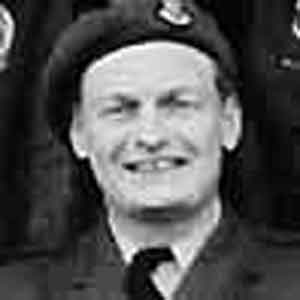| Group Captain Peter William Gilpin CBE DFC - 4 Sqn CO Aug53 to Dec55. | ||
|
Peter Gilpin, unable to go to the RAF College because of the war's arrival, studied Aeronautical Engineering at Southampton until joining the RAF and was trained in Arizona at Falcon Field*, now the Falcon Field airport for Mesa. On return to UK Peter joined 253Squadron, by then mainly at Hibaldstow and Friston, preparing for operations and the invasion of North Africa to where they deployed from Gibraltar with their Hurricane 11's to Maison Blanche (French name for the same Arabic meaning, corrupted into Algiers). 253 arrived in Algeria a few days after the Allied landings. The squadron provided air cover for the Army and its supply lines during the Tunisian campaign and its aftermath, moving to Italy in October 1943. In February 1944, 253 arrived in Corsica to undertake escort and anti-shipping missions, returning to Italy in April for similar duties over Yugoslavia. It was at this stage Peter was shot down over Yugoslavia and had already been awarded his DFC. From March 1943 they had Spitfire V's before the hurricanes finished in Sep43 with the arrival of their Spitfire iX's. Peter remained as a POW until the end of the war. While at Hucknall and in the Mess at Watnall in 1946, Peter met Helen who served 4 years as a plotter and they were engaged and married within three weeks of meeting each other. 1947 saw him at Manchester UAS and then learning to become a QFI at Rissington and instructing at Dalcross before promotion and returning to South Cerney as a Sqn Ldr. Peter after his OCU conversions took command of No IV(AC) Sqn at Jever in August, 1953, still with its Vampire FB5's and 9's, and before the arrival of its Sabre F4's in March 1954. He commanded throughout the Sabre era with IV Sqn until the Sabres' departure in August 1955, again having the re-equipment, now with Hunter F Mk 4's, in July 1955, five months before his departure and handover to Sqn Ldr J R (Ray) Chapman. How pleased IV (AC) Sqn was to have them both up as guests at Cottesmore, which I imagine was the 90th Anniversary, with the IV Sqn Hunter remaining there in front of the Sqn until the closing down of Cottesmore, now Kendrick Barracks, but with that Hunter about to become a symbolic and by now a much refurbished "F/GA Mk 9", as a commemoration of No. 8 Sqn's long past in the Middle East. 8 Sqn has been now for so long at Waddington with its Sentry AEW AWACS Boeing E-3A's. Staff College at Camberley followed, then Shinfield Park Flying Training HQ and becoming Chief Flying Instructor at CFS Little Rissington in 1958-60 followed by Gp Capt Plans in SEAF at Changi then JSSC staff at Latimer. He was promoted Gp Capt in 1965 and became Stn Cdr at RAF Oakington in 1968, on the staff at Camberley Staff College (at dates which are not known to me) and did a long stint as Gp Capt Intelligence at MOD(Air) before his September 1977 retirement to his long term home at delightful Burford in the Cotswolds. Once again our sincere thanks and shared condolences to Mrs Helen Gilpin and their extended family. (Thanks to Al Pollock). *from Wiki: Falcon Field got its start prior to World War II, when Hollywood producer Leland Hayward and pilot John H. "Jack" Connelly founded Southwest Airways with funding from friends like Henry Fonda, Fred Astaire, Ginger Rogers, James Stewart, Hoagy Carmichael and others. Southwest Airways operated two other airfields in Arizona - Thunderbird Field No. 1 (now the site of Thunderbird School of Global Management) and Thunderbird Field No. 2 (now the site of Scottsdale Airport) - to train pilots from China, Russia and 24 other Allied nations. Falcon was to be Thunderbird Field III and would train British pilots. The British said they'd like the field to be named after one of their birds, and thus Falcon Field was opened as the No 4 British Flying Training School (BFTS). There were six BFTS airfields in the U.S., in Florida, Oklahoma, Texas, California and Arizona. In September 1941, the first cadets of the British Royal Air Force arrived. They trained in Stearman PT-17 biplanes and North American Aviation AT-6 Harvard monoplane trainers. The good weather, wide-open desert terrain, and lack of enemy airpower provided significantly safer and more efficient training than was possible in England. Even so, twenty-three British cadets, one American cadet and four instructors were killed in training and are now buried in the Mesa City Cemetery, along with several of their colleagues who have since died of natural causes. Several thousand pilots were trained there until the RAF installation was closed at the end of World War II. The City of Mesa purchased the field from the U.S. government for $1. |
